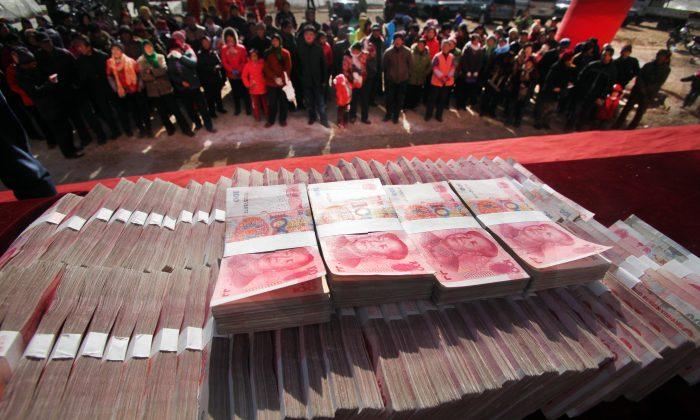When looking at the latest moves by Chinese monetary authorities, one gets the impression that things are out of control.
In December, China sold a record $48 billion in U.S. Treasurys, a liquidity-draining move, provided the dollars were converted back into yuan.
In January, China’s central bank, the People’s Bank of China (PBOC), forced banks to lend out $218 billion (that is, create credit money), the largest monthly amount on record. A surge in liquidity in January is not uncommon given the date of the Chinese New Year, a time when people demand more cash and banks are closed for a week. Still, it’s the largest amount on record.
Shortly after the Chinese New Year, the PBOC took out excess liquidity to the tune of $16 billion with normal repo transactions.
But the real shocker followed on Tuesday when the Chinese yuan closed below the official PBOC fixing price for the first time since September 2012. It also registered the largest seven-day drop (0.95 percent) against the dollar since 1994.
Why is this shocking? Since the beginning of the Chinese growth story, the yuan has been steadily rising in value against the dollar as more money flowed into China. Through intervention, the PBOC has managed to slow the appreciation of the yuan. This is a big move against one of the most established trends in financial markets.
It’s Neomercantilism
The chaotic and confusing moves of the Chinese authorities point straight at the weakness of the Chinese economic model.
It started with cheap everything at the beginning of the 1990s. Cheap land, cheap labor, and a cheap exchange rate—the perfect recipe for a neomercantilist economic model of ultracompetitive export goods, high employment, and fast growth.
This model worked until the financial crisis of 2008, when Western countries stopped buying Chinese goods as their economies approached a terminal meltdown. Because the Chinese regime needs to avoid social unrest and high unemployment at all costs, it had to create growth another way.
It unleashed a $600 billion stimulus program at the end of 2008. The money flowed into fixed assets such as new factories, airports, roads, trains, and homes. But the $600 billion was just the beginning. Through its banks, the Chinese regime created loans worth $14 trillion, sending more money flowing into these projects.
And the plan worked. Unemployment remained low and GDP kept growing rapidly. The problem, most of the so-called investments don’t produce any cash flows, because they don’t have any real use. They were only undertaken to generate growth and distribute money.
A few years and a few trillion down the road, the Chinese authorities know that this trajectory cannot go on forever, which is why they keep talking about deleveraging.
However, they also know that they can’t just pop the bubble, because an uncontrolled deleveraging would lead to unemployment and chaos, precisely the scenario the regime wants to avoid.
This Catch-22 would explain the erratic moves to drain and add liquidity, trying to achieve two opposing goals at the same time.
Dead End
So authorities naturally had to shift their focus back on the neomercantilist approach that worked so well in the first place and they are trying to lower their exchange rate.
The problem: Thanks to the money printing of the Fed and the PBOC, things aren’t cheap in China anymore. Land prices have exploded and wages have risen.
Adjusted for inflation and on a trade-weighted basis, China’s Real Effective Exchange Rate is at an all-time high. Other countries like Vietnam, the Philippines, and even Mexico, are now more competitive in terms of unit labor costs.
So the only way out seems to be to take the path of currency devaluation. But even that road might lead to a dead end because of the makeup of the PBOC’s balance sheet.
No Yuan
In order to cheapen the yuan, the PBOC has to sell yuan and buy dollars. So far, so good. But in order to avoid further price inflation with the move, the PBOC would have to sell off existing yuan assets on its balance sheet and exchange them for dollars.
However, because of the small size of Chinese fixed-income capital markets, yuan-denominated assets of the PBOC’s balance sheet made up only 15 percent of total assets at the end of the third quarter of 2013. The rest is all in foreign reserves and selling those would actually strengthen the yuan. So the PBOC needs to print money to buy dollars, like it has done in the past.
But printing more money promotes further credit creation and more bubbles. It will also lead to further increases in domestic prices and a loss of competitiveness. For the PBOC, this is truly a zero-sum option.






Friends Read Free